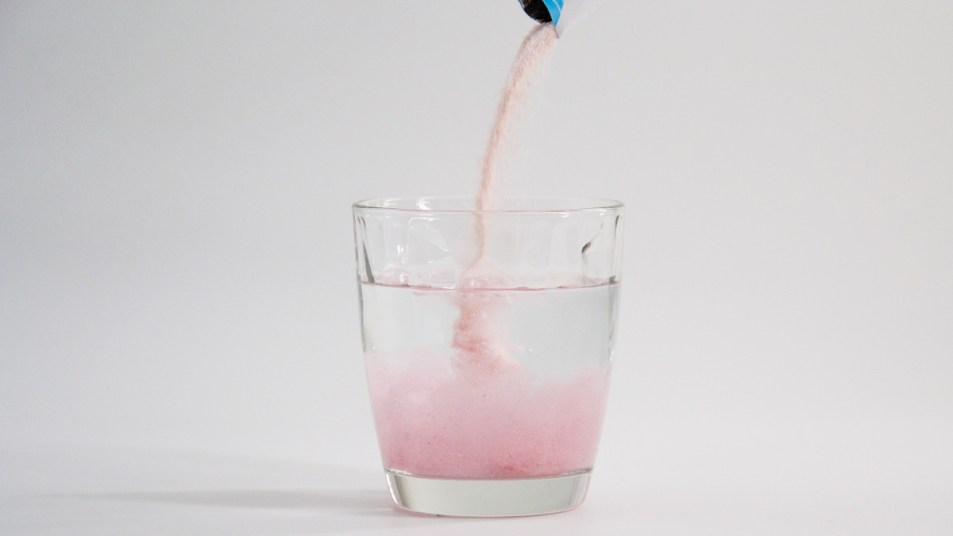Do ‘Hydration Multipliers’ Actually Work? It Depends, Say Experts
You may be better off with plain water.

Being thirsty stinks. And sometimes, plain old water just doesn’t hit the spot. So if you’ve ever seen advertisements for powders you can add to your water to make it more hydrating (and more palatable), you might be intrigued. But are these “hydration multipliers” right for you? Keep reading to see what experts have to say about hydration multipliers — and whether or not they’ll quench your thirst better than straight H2O.
What is a hydration multiplier?
Also called “electrolyte powders,” hydration multipliers are (usually flavored) powders you can add to water to boost its ability to replenish your fluids. They contain sugars (glucose) and electrolytes like magnesium, potassium, and sodium to transport water throughout your body more efficiently. According to Texas Health, the technology is called Cellular Transport Technology (CTT), and the idea behind it is that the specific ratios of electrolytes found in these powders can help you get more hydration on a cellular level from the water you’re drinking.
What are the advantages of hydration multipliers?
Texas Health notes that sometimes, water isn’t enough to tackle severe dehydration. Therefore, the minerals in hydration multipliers can be more effective than sugary sports drinks and just as effective as IV hydration therapy in getting your fluid levels back on track, thanks to their electrolyte content.
Electrolytes are vital for our health, and they’re especially important for those who are losing a lot of fluid through exercise or illness. “Electrolytes conduct electricity, and are necessary for nerve and muscle function, as well as fluid balance … when you do not consume enough electrolytes, you may experience muscle cramps, or in a worst-case scenario, low blood sodium, which can be very dangerous,” sports dietitian Marie Spano tells VeryWellFit.
The average person gets a majority of their electrolytes from their diet, through foods like fruits, vegetables, eggs, dairy, and meat. But for those who are exercising heavily or aren’t feeling well and can’t consume solid foods, hydration multipliers are an effective, convenient way to replenish electrolytes.
Hydration multipliers are also easy to customize to your specific needs. You can add them to anything you’re drinking, and “you can easily use more or less powder as needed,” says Spano. “Since you mix them in water, you’re hydrating while you’re getting your electrolytes.”
What are the disadvantages of hydration multipliers?
While hydration multipliers are convenient and seem to be a quick cure-all for chronic dehydration, they’re not always the best solution, depending on your needs. Hydration is important, but too much of a good thing is, well, too much. You really only need extra electrolytes if you’re at a deficit, especially if you’re eating a balanced diet, says VeryWellFit. You may need more electrolytes if you’re suffering from diarrhea or vomiting; you’re exercising strenuously; or you’re sweating excessively. If it’s everyday sipping, not so much.
The popular stat is that 75 percent of Americans are chronically dehydrated, but according to medical reference resource StatPearls, the truth is that dehydration is common in just 17 to 28 percent of older adults in America. That’s still a lot of people; however, over-diagnosis of dehydration, which is treatable and preventable, can lead to negligence of a patient’s more serious problems.
“The elderly population is… 20-30 percent more prone to developing dehydration due to immobility, impaired thirst mechanism, diabetes, renal disease, and falls,” say StatPearls researchers. So, if you’re an older adult experiencing dehydration, the solution to your problem may be more nuanced than simply drinking more water. It’s therefore important to seek medical attention if you feel chronically dehydrated before simply increasing fluid and electrolyte intake.
Hydration multipliers also contain a lot of sodium — over 300 milligrams a serving — as necessary for CTT. But if you’re drinking hydration multipliers every day on top of a regular diet, you could be getting too much sodium, as well as too many electrolytes.
Hypernatremia, or the state of having too much sodium, can cause diarrhea, vomiting, and dizziness. And too many electrolytes, like potassium and magnesium, can additionally cause nausea, confusion, muscle weakness, and heart arrhythmia. In serious cases, electrolyte excess could even damage kidney and neurological function.
The Bottom Line
If you’re in extreme heat, sweating a lot, exercising strenuously, or suffering from illness-related fluid loss, hydration multipliers might be a good option for you. However, if you’re eating a balanced diet and aren’t losing a lot of fluids, you may be taking in too many electrolytes or too much sodium with hydration multipliers — so skip them. If you feel like you can’t get enough fluids to feel satisfied, talk to your doctor, as you might have an underlying medical condition.
This content is not a substitute for professional medical advice or diagnosis. Always consult your physician before pursuing any treatment plan.













